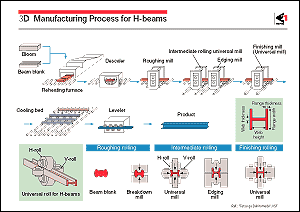H-beams have a large geometrical moment of inertia per unit weight and resist bending and twisting, and are therefore used as columns, beams, and bridge girders in architectural and civil construction.
Products such as H-beams, whose cross-sectional shape is not rectangular, can also be produced by rolling. The figure shows the rolling equipment, forming process and names of the parts of an H-beam.
Here, caliber rolling is conducted in the roughing stage. The materials are rolled by caliber rolls in order to obtain the same cross-sectional shape as that of the rolls. After producing a near H shape by caliber rolling, the product is finished by a universal mill and an edging mill. An H-shaped cross-section is formed when the material passes through four rolls, making the universal mill, which is equipped with a pair of vertical rolls and a pair of horizontal rolls, suitable for rolling H-beams. The edging mill is equipped with caliber rolls as shown in the figure, and has the function of adjusting the flange widths of products.
In the universal mill, variations of flange- and web- thickness can be made easily by adjusting the roll gap. However, when products with different web heights and flange widths are to be rolled, it is necessary to employ exclusive-use rolls for these sizes, necessitating roll changes. In particular, since the web heights are determined by sum of the width of the horizontal rolls and flange thickness, it has to date been necessary to have the same number of horizontal roll sizes as product web heights. Development to overcome this problem has resulted in recent rolling mills and rolling techniques capable of adjusting the web heights by one roll with changeable width without changing rolls.
By combining caliber rolling with universal rolling, it is also possible to roll steel products of non-H shape, such as sheet piles, channels, angles, and rails. |
|
 |
 |
 |
|
|